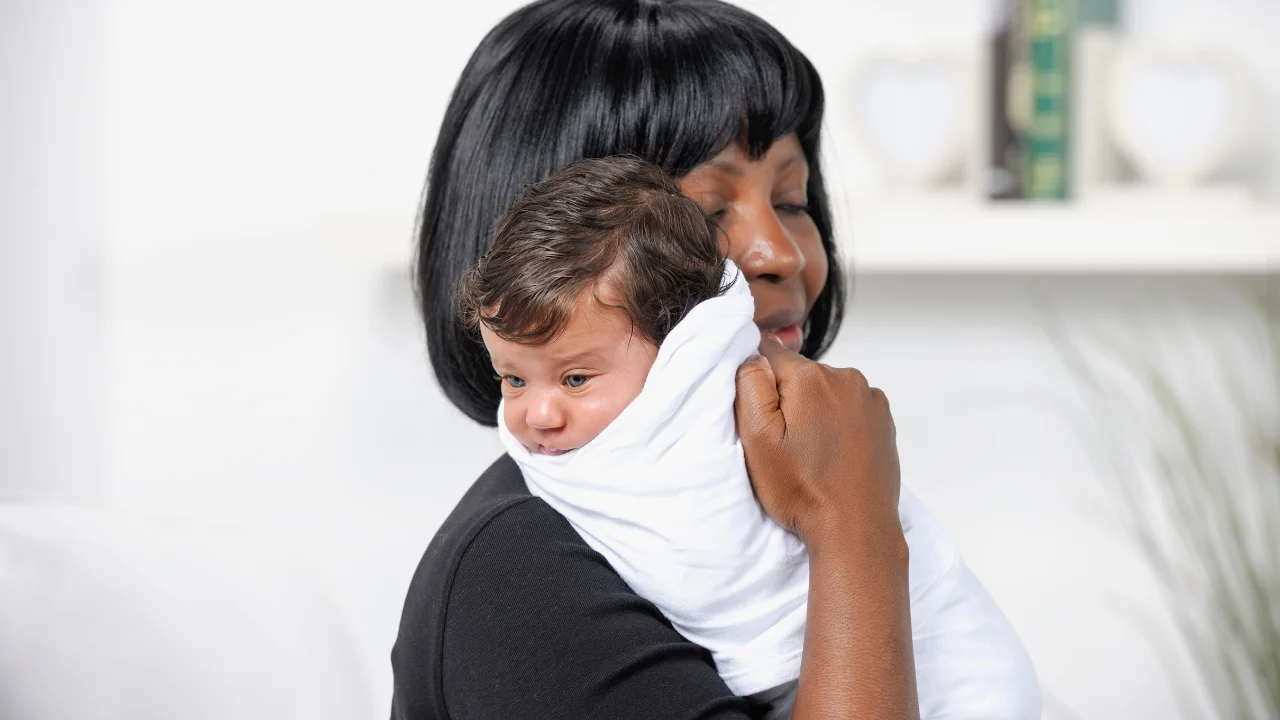
የሕፃን እንቅልፍ! የሕፃናት ሐኪም "አምስት ኤስ" ዘዴ አዲስ የተወለዱ ሕፃናትን ለማረጋጋት እና እንቅልፍ እንዲተኛላቸው ይረዳል. አምስቱ ኤስ መወዛወዝ፣ የጎን ወይም የሆድ አቀማመጥ፣ መጨፍጨፍ፣ ማወዛወዝ እና መጥባት ናቸው። እነዚህ አምስት ነገሮች የማህፀን አከባቢን እንደገና ለመፍጠር ይረዳሉ, ይህም ለልጅዎ መጽናኛ ሊሆን ይችላል.
በዚህ ጽሑፍ ውስጥ
ከእንቅልፍ ህጻን የበለጠ ጣፋጭ እይታ የለም, ነገር ግን ልጅዎን እንዲተኛ ማድረግ ወደ ዕለታዊ ትግል ሊለወጥ ይችላል.
እርስዎ እርዳታ የሚፈልጉ እንቅልፍ የተነፈጉ አዲስ ወላጅ ከሆኑ፣ የሚያለቅሱትን ወይም የሚረብሹን ሕፃናትን ለማስታገስ እና እንዲተኙ ለማድረግ የሕፃናት ሐኪም ሃርቪ ካርፕ ዘዴን መሞከር ይፈልጉ ይሆናል። በእሱ ዘዴ እምብርት አምስቱ S: ስዋድል, የጎን ወይም የሆድ አቀማመጥ, ሹሽ, ማወዛወዝ እና መጥባት ናቸው.
"በጣም ደስተኛ ህፃን" ዘዴ
ካርፕ አዲስ የተወለደውን ልጅዎን ለማረጋጋት እና እንዲተኙ ለማድረግ ከሁሉ የተሻለው መንገድ የማህፀን ጫጫታ, እንቅስቃሴ እና ምቹ አካባቢን እንደገና በመፍጠር ነው. በመጽሃፉ ላይ የተገለጸው የ"አምስት ኤስ" የሕፃን እንቅልፍ ስልት፣ በብሎክ ላይ በጣም ደስተኛ የሆነው ህፃን፣ ይህን ለማድረግ የተነደፈ ነው።
ካርፕን ጨምሮ ብዙ ባለሙያዎች ከተወለዱ በኋላ ያሉትን የመጀመሪያዎቹን ጥቂት ወራት “አራተኛው ሳይሞላት” ብለው ይገልጻሉ። ህጻናት ከማህፀን ውጭ ናቸው, ግን ለዓለማችን በጣም ዝግጁ አይደሉም. የሰው ልጆች ልዩ እንክብካቤ ያስፈልጋቸዋል ምክንያቱም ሲወለዱ ከአብዛኞቹ አጥቢ እንስሳት ሕፃናት ጋር ሲነጻጸሩ ያልበሰሉ ናቸው። (አንድ ምሳሌ፡- አዲስ የተወለደ ፈረስ መራመድ ይችላል፣ሰዎች ግን ለመንቀሳቀስ ወራት ይወስዳሉ።)
ብዙ አዲስ ወላጆች አዲስ የተወለዱ ሕፃናት መረጋጋት እና ጸጥታ እንደሚያስፈልጋቸው ሊገምቱ ይችላሉ, ነገር ግን ገና የወጡበት ቦታ በጣም ንቁ እና ጫጫታ ነው. በማህፀን ውስጥ ያሉ ሕፃናት ይንቀጠቀጣሉ እና ይንቀጠቀጣሉ. በእናታቸው አካል በሚያሽሟጥጡ እና በሚያጎርፉ ድምጾች ወድቀዋል እና በ"ክፍላቸው" ግድግዳዎች ተጭነዋል።
ስለዚህ ጸጥ ባለ የችግኝት ክፍል ውስጥ ብቻቸውን ሲተኙ፣ እጆቻቸውና እግሮቻቸው ሲላቀቁ እና ሲኮማተሩ በራስ የመተማመን እና የደስታ ስሜት ሊሰማቸው ቢችል ምንም አያስደንቅም። ከማህፀን ጋር ተመሳሳይነት ያለው አካባቢ መፍጠር አዲስ የተወለዱትን ልጆቻችሁን ሊያጽናና እና የተሻለ እንቅልፍ እንዲተኛ ሊረዳቸው ይችላል - አምስቱን ኤስ ያስገቡ.
አምስቱ S የሕፃን እንቅልፍ
ካርፕ ሁሉንም አምስቱን Sዎች እንዲሰሩ እና እያንዳንዳቸው በትክክል እንዲሰሩ ጥንቃቄ እንዲያደርጉ ቢመክርም, እያንዳንዱ ህፃን የተለየ ነው. ልጅዎ የማይፈልጋቸው ከሆነ ሁሉንም አምስቱን Ss መከተል አያስፈልግዎትም. አንዳንድ ሕፃናት ለምሳሌ በጎን ወይም በሆዳቸው ላይ መታጠቅ ብቻ ያስፈልጋቸዋል። ይሞክሩት እና ለትንሽ ልጅዎ የሚሰራውን ይመልከቱ።
የካርፕ ዘዴ በመጀመሪያዎቹ አራት ወራቶች ህጻናት ላይ ያነጣጠረ ነው. አንዴ ልጅዎ 4 ወር ሲሆነው፣ አዲስ ከተወለዱት ደረጃዎች ውጭ ናቸው እና የእንቅልፍ እና ምቾት ፍላጎቶቻቸው የተለያዩ ናቸው።
Swaddling
መዋኘት ሕፃናትን ከመውለዳቸው በፊት የሚደሰቱትን አስተማማኝ ስሜት በመስጠት ያስታግሳል። እንዲሁም የልጅዎ እጆች እንዳይወዛወዙ ይከላከላል እና ድንጋጤን ይከላከላል፣ ይህም እንደገና የመበሳጨት እና የማልቀስ ዑደቱን ሊጀምር ይችላል።
ስዋድዲንግ ከባድ አይደለም, ነገር ግን ቴክኒኩን በትክክል ማግኘት በጣም አስፈላጊ ነው, ስለዚህ ስዋዲው ደህንነቱ የተጠበቀ እና ውጤታማ ነው. ቀጭን ብርድ ልብስ መጠቀም ትችላለህ፣ ወይም በመጠቅለያ መግዛት ትችላለህ ቬልክሮ ትንሹን ልጅዎን ለመጠቅለል ቀላል እና ፈጣን ያደርገዋል።
ሀሳቡ ህጻናትን ከሽምግልና ለመውጣት እንዳይሞክሩ በጥሩ ሁኔታ መጠቅለል ነው, ነገር ግን እግሮቻቸውን ወደ ላይ እና ከሰውነታቸው ለማውጣት ከብርድ ልብሱ ስር በቂ ቦታ ይተዉላቸው. ልጅዎን ለመተኛት፣ ለሊት እና ሲያለቅስ እንዲታጠቡ ያድርጉ። ሲነቁ እና ሲደሰቱ አይስቱ።
ልጅዎ የመንከባለል ምልክቶች ካዩ በኋላ መዋጥ ለማቆም ጊዜው አሁን ነው። ይህ አብዛኛውን ጊዜ የሚከሰተው በ 3 ወይም 4 ወራት አካባቢ ነው, ግን እስከ 2 ወር ድረስ ሊሆን ይችላል.
የጎን ወይም የሆድ አቀማመጥ
አሁን ልጅዎን ዋጥ አድርገው፣ የሚያለቅሱትን ወይም የሚጨናነቀውን ህጻን በሚይዙበት ጊዜ ከጎናቸው ወይም ከሆዱ ላይ በማድረግ ማረጋጋት መጀመር ይችላሉ።
አደጋን ለመቀነስ ድንገተኛ የሕፃናት ሞት ሲንድሮም (SIDS)፣ ልጅዎን በጀርባው ላይ እንዲተኛ ማድረግ እጅግ በጣም አስፈላጊ ነው። ነገር ግን አዲስ የተወለዱ ሕፃናት በጎናቸው ወይም ሆዳቸው ላይ የበለጠ ደህንነት እና እርካታ ስለሚሰማቸው፣ እነዚያ ለማረጋጋት (ለመተኛት ሳይሆን) በጣም ጥሩ ቦታዎች ናቸው።
የሚያንገበግበውን ወይም የሚያለቅሰውን ሕፃን ከጎን ወይም ከሆድ በታች በሆነ ቦታ በእጆችዎ፣ በጭንዎ ላይ ወይም በትከሻዎ ላይ ይያዙት። ይህንን “S” ጨቅላዎን ለማስታገስ ብቻ ይጠቀሙ። በሚተኙበት ጊዜ በጎናቸው ወይም በሆዳቸው ላይ በጭራሽ አያስቀምጧቸው. ተኝተው ከሆነ ጀርባቸው ላይ አስቀምጣቸው።
ሹንግ
ሹሺንግ ልጅዎን የሚያረጋጋ እና የሚያጽናና፣ ማልቀስ እና መበሳጨት እንዲያቆም የሚረዳ እና እንዲተኙ እና እንዲተኙ የሚረዳ ድምጽ ነው።
አዲስ የተወለዱ ሕፃናት ዝምታ አያስፈልጋቸውም. በእውነቱ ፣ በማህፀን ውስጥ ለወራት ብቻ ካሳለፉ - የእናቶች የደም ፍሰት ከቫኩም ማጽጃ የበለጠ የሚጮህ ድምጽ በሚያሰማበት - ጫጫታ ባለው አካባቢ ውስጥ በተሻለ ሁኔታ ይተኛሉ። (እነሱ ደግሞ የበለጠ ደስተኛ ናቸው, እና በተሻለ ሁኔታ መረጋጋት ይችላሉ.).
በጣም ቀላል በሆነ መልኩ የ"ሹሽ" እርምጃውን በጎናቸው ወይም በሆድዎ ሲይዙ በታጠቀው ህጻን ጆሮዎ ላይ ጮክ ብለው "shhh" በማለት ይተገብራሉ። ከንፈርዎን ከልጅዎ ጆሮ አጠገብ ያድርጉ እና ጮክ ብለው "shhh" (ብዙውን ጊዜ በእርጋታ እያንኳኳቸው - ከታች ይመልከቱ)።
ልጅዎ እያለቀሰ እንዳለ ጮክ ብለው ይዝጉ። ሲረጋጉ፣ ለመዛመድ የሹንግዎን ድምጽ ይቀንሱ።
እንዲሁም ሀ መጠቀም ይችላሉ ነጭ የድምጽ ማሽን ልጅዎ በሚተኛበት ጊዜ. አንዳንድ ድምፆች ከሌሎቹ የበለጠ ውጤታማ ናቸው. ካርፕ የደጋፊዎች፣ የድምፅ ማሽኖች እና የውቅያኖስ ሞገድ ቀረጻዎች ላይሰሩ እንደሚችሉ ተናግሯል፣ እና በጣም ዝቅተኛ እና “የሚርመሰመሱ” (በማህፀን ውስጥ ያሉ ድምፆች ያሉ) ድምፆችን ይመክራል። ሙከራ ማድረግ እና ልጅዎን ምን እንደሚረዳ ማየት ይችላሉ.
ልጅዎን ለማረጋጋት ልጅዎ እያለቀሰ ያህል ድምጾቹን ጮክ ብለው ያጫውቱ። ከእንቅልፍ ጋር አብሮ ለመጓዝ እንደ ሻወር ጮክ ብለው ይጫወቷቸው።
ማወዛወዝ
የሕፃን ማወዛወዝ የመጀመሪያ ሐሳብህ ሊሆን ይችላል፣ ነገር ግን በዚህ ጉዳይ ላይ "ማወዛወዝ" ማለት ይህ አይደለም። በምትኩ፣ በጣም ትንሽ እና ፈጣን እንቅስቃሴዎችን በመጠቀም የታጠቀውን ህጻንዎን መንቀጥቀጥን ያመለክታል።
በማህፀን ውስጥ ልጅዎ ብዙ ጊዜ ይንቀጠቀጣል፣ ይንቀጠቀጣል ወይም በሌላ መንገድ ይንቀሳቀስ ነበር። ይህ "S" የተለመደ እና የሚያጽናና ያደርገዋል. የታጠበውን ህጻን በጎን ወይም በሆድ ቦታ ላይ እየጮሁ (ወይም ነጭ ጫጫታ ሲጫወቱ) ያድርጉት።
አዲስ የተወለደውን ጭንቅላት መደገፍ እና በእርጋታ መወዛወዝ - አትናወጡ – ልጅዎን ያረጋግጡ። ካርፕ በማንኛውም አቅጣጫ ከአንድ ኢንች የማይበልጥ ወደ ኋላ እና ወደ ፊት የሚንቀሳቀስ ከመንቀጥቀጥ የበለጠ “የሚንቀጠቀጥ” እንደሆነ ይገልፃል።
በካርፕ አስተያየት, ሌሎች የእንቅስቃሴ ዓይነቶች (በሚወዛወዝ ወንበር ላይ መወዛወዝ, በህጻን መወዛወዝ ወይም በወንጭፍ ውስጥ መወሰድ, ለምሳሌ) ለተረጋጋ ህፃናት ጠቃሚ ናቸው, ነገር ግን ይህ ለስላሳ ጅግ ለሚያለቅስ ሕፃን የበለጠ ውጤታማ ነው.
መምጠጥ
ይህ በቀላሉ ለልጅዎ መስጠት ማለት ነው። ማስታገሻ ወይም ለመጥባት አውራ ጣት. አንዳንድ ህጻናት ለመምጠጥ ይወዳሉ እና በእሱ ውስጥ ትልቅ ምቾት ያገኛሉ. ልጅዎ በዚያ ካምፕ ውስጥ ከሆነ፣ ጡት ማጥባት ዘና እንዲሉ እና እንዲረጋጉ ሊረዳቸው ይችላል።
የታጠቀውን ህጻን ፓሲፋየር ወይም እርሶ ይስጡት። አውራ ጣት ከተናደዱ እና ለመጥባት የሚፈልጉ ይመስላሉ. ከጎናቸው ወይም ሆድ ከመያዝ፣ በታላቅ ጩኸት ወይም በነጭ ጫጫታ ማስታገስ እና በቀስታ መንቀጥቀጥ፣መምጠጥ ልጅዎን ለማረጋጋት ዘዴውን ሊጠቅም ይችላል።
ማስታገሻዎች የSIDS ስጋትን ሊቀንሱ ይችላሉ፣ እና ልጅዎ በሚተኛበት ጊዜ ማጥፊያውን እንዲይዝ መፍቀድ ምንም ችግር የለውም። አንዳንድ ባለሙያዎች ጡት ማጥባት እስኪረጋገጥ ድረስ ለልጅዎ ማጥባት እስኪሰጥ ይጠብቁ ይላሉ፣ ምክንያቱም ማጥባት ጡት መጥባት ጡትን ከመምጠጥ የተለየ ስሜት ስለሚሰማው እና መጥበሻው ቀደም ብሎ መመገብ ላይ ጣልቃ ስለሚገባ።
ተጨማሪ ያንብቡ


አስተያየት ጨምር